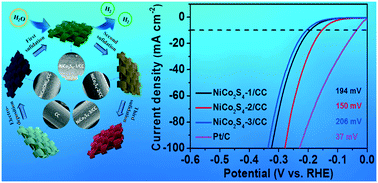Sulfur vacancy-tailored NiCo2S4 nanosheet arrays for the hydrogen evolution reaction at all pH values†
Abstract
The development of efficient, stable and inexpensive electrochemical water-splitting catalysts for the hydrogen evolution reaction (HER) over a wide range of pH is of great importance for the production of hydrogen resource. Defect engineering with electronic structure modulation has been expected to be an effective strategy to enhance the electrocatalytic activity. Herein, Ni–Co bimetallic sulfide (NiCo2S4) nanosheet arrays with controlled sulfur vacancies have been developed by multiple vulcanization treatment of the Ni–Co hydroxide precursor for HER catalysis at all pH values. The presence of S vacancies has been identified by various characterization means, and their effects on the HER performance are well investigated. The obtained NiCo2S4 nanosheet arrays with optimal sulfur vacancy content exhibit the best HER performance in alkaline medium, only requiring an overpotential of 150 mA at −10 mA cm−2 with a Tafel slope of 82.5 mV dec−1, as well as excellent durability. Experimental results confirm that the high HER activity could be ascribed to the accelerated electron transfer and good intrinsic activity for the electrocatalyst with optimal S vacancies. These findings should provide a new vacancy modulation for traditional transition metal chalcogenides for the purpose of boosting the HER performance at all pH values.



 Please wait while we load your content...
Please wait while we load your content...